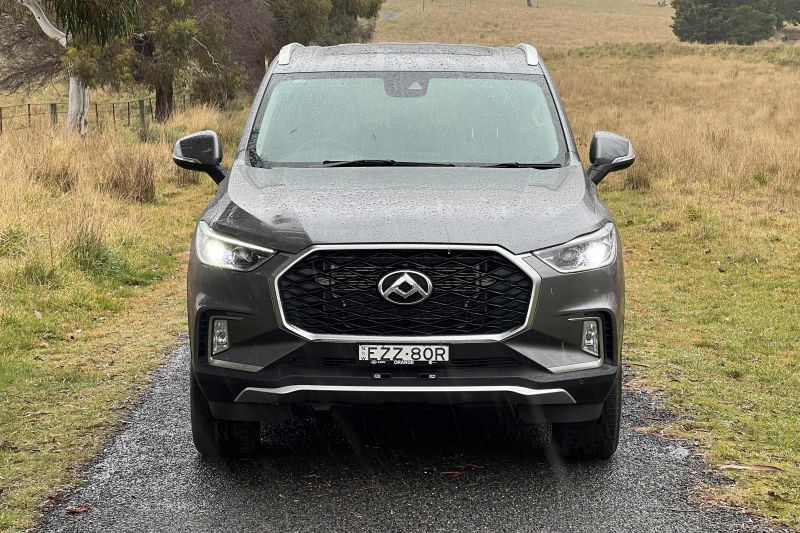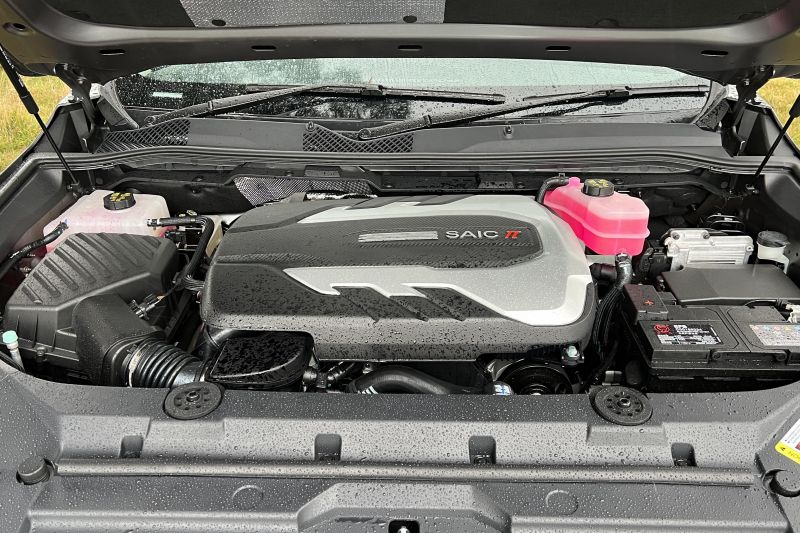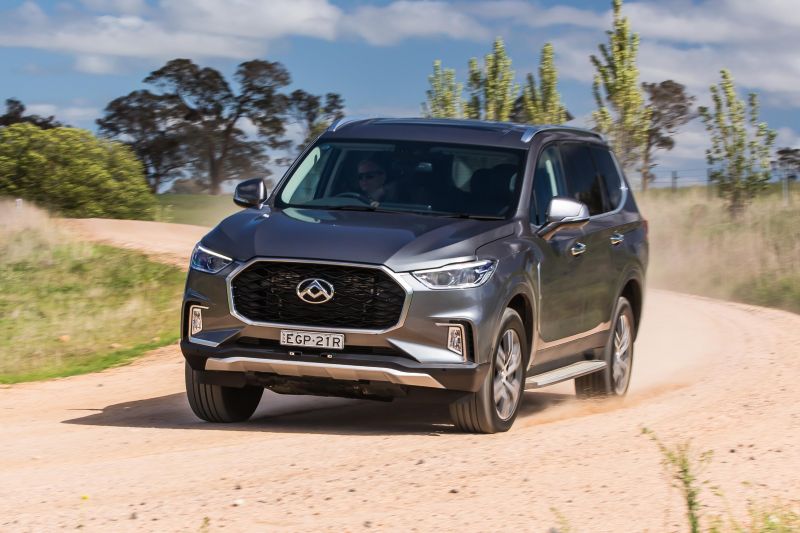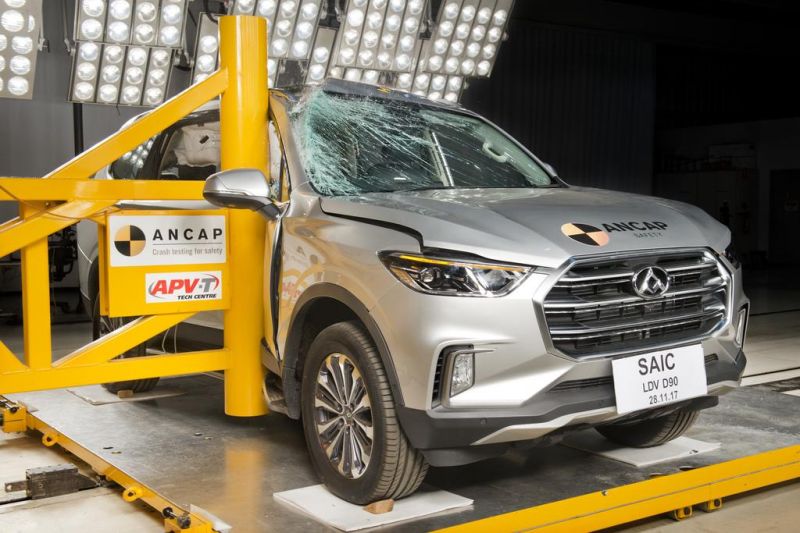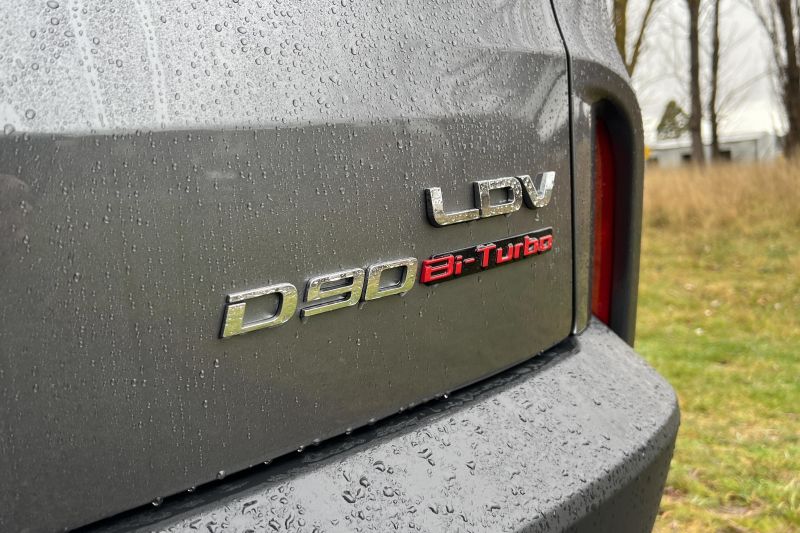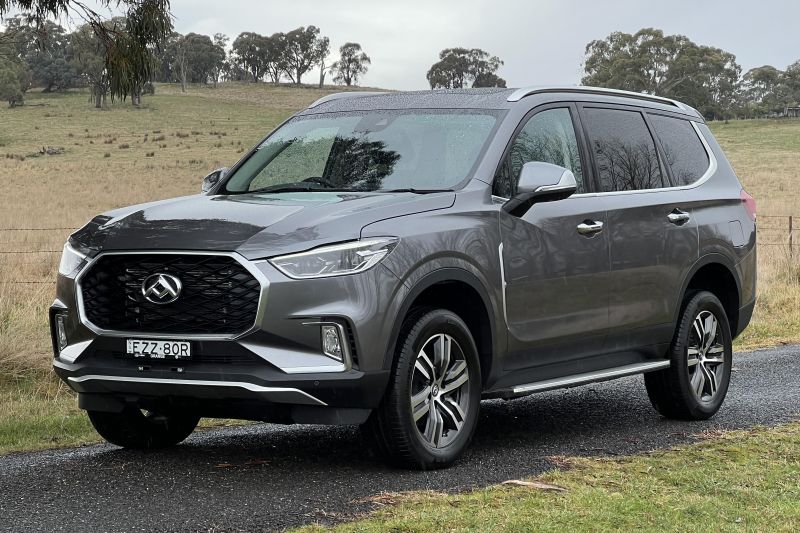If you want a whole lot of SUV for not a whole lot of money, the LDV D90 makes a lot of sense.
This large, three-row, body-on-frame 4WD has been around for years now, and the purpose of this review was to see if this family-friendly option is worth considering against some more fancied rivals in the ute-based-SUV space.
In short – yes it is. But you might not need to buy the diesel version to get the best value here.
I drove this brand-new 2023 LDV D90 Diesel Executive 4WD courtesy of my mates at Orange LDV in NSW, and I’m telling you, there’s plenty to like here… and some stuff that could be better – read on to find out more.
How much does the LDV D90 Executive 4WD cost?
That entry-grade pricing makes this the most affordable seven-seat SUV on the market ($38,937 drive-away), better than the likes of the fleet-focused Mitsubishi Outlander ES (from $37,240) and the Nissan X-Trail ST (from $39,790).
It also puts it in a more affordable position than larger, more direct rivals like the Mitsubishi Pajero Sport (from $44,940), while the most affordable Isuzu MU-X is $48,900, the Toyota Fortuner starts from $51,965, and the cheapest Ford Everest is $53,920 – all prices exclude on-road costs
So the pricing is strong for this large SUV, especially if you’re considering a petrol version. I’ll cover off the standard equipment further down. The version we have on test, the top-spec Diesel Executive 4WD, is $52,095 drive-away.
Below is a rundown of the LDV D90 range, and the diesel version tested here is marked in bold to make it easier for you to see why it might not make as much sense for some buyers as the more affordable petrol models
Note these are the private buyer drive-away prices, and there’s a second list for ABN (Australian Business Number) holders.
2023 LDV D90 pricing:
- D90 Petrol 2WD: $38,937
- D90 Petrol Executive 2WD: $43,147
- D90 Petrol Executive 4WD: $46,832
- D90 Diesel Executive 4WD: $52,095
ABN holder pricing:
- D90 Petrol 2WD: $36,990
- D90 Petrol Executive 2WD: $40,990
- D90 Petrol Executive 4WD: $44,490
- D90 Diesel Executive 4WD: $49,490
All prices are drive-away
What is the LDV D90 Executive 4WD like on the inside?
There are some more mature vehicles in this segment that feel very, very outdated when it comes to the interior design and features. The D90 is pretty contemporary, reasonably stylish, but – most importantly – very practical.
The cockpit features a few handy storage spaces, such as a covered centre bin (with carbon-fibre-look trim, for some reason), cup holders, a covered centre console bin, bottle holders in the doors and a decent glove box.
There are some controls down between the front seats near the e-shifter gear selector; including the 4WD selector, and drive mode selector off-roading. Plus that’s also where you’ll find the button to turn off the lane departure warning, as well as hill descent control and auto start-stop buttons.
As for the climate controls? There are buttons – how good! So much better than the touchpad-style control panel in the T60 ute. There are dials for temperature adjustment, and buttons for fan speed, demister and recirculation.
The media screen doesn’t have the greatest responsiveness at times, however. The menu buttons are a bit small and the functions can at times be slow to respond. I don’t love that there’s no volume dial, either, but the fact there’s wired Apple CarPlay could mean its a simple set-and-forget system for some.
There’s also a part-digital instrument cluster with trip computer details and a digital speedo, flanked by analogue speed and rev readouts.
While it might seem funny to have fake carbon-fibre, it seems even further in the odd-zone when you see the red ambient lighting. This family SUV thinks it’s an angry race car.
In the second row there is a 60:40 bench seat with the larger portion on the kerbside of the car. In my mind, that seems a bit silly, because you’re likely going to want the smaller (easier to move) portion where people will slide the seat fore and aft most. But this larger-portion part of the seat features a flip-up base section that allows it to move further forward, allowing access to the third row.
Both sections can slide to allow better space for third-row occupants, or a more accommodating area for those in the middle row, and there’s ample room for adults. I was very comfy in there with the seat set to allow space for third-row occupants of the same size, and I’m bigger than average for an Aussie, at 182cm / 6’0”.
The amenities are good in this spec too, with a separate climate zone and fan controls for the rear rows, lighting, and a selection of power options for charging – 12-volt, USB-A and 220-volt outlets. There’s also a flip-down armrest with cupholders, bottle holders in the doors, and map pockets on the seatbacks.
There are window-seat ISOFIX mounts, and three top-tether points in the second row. You won’t find any child-seat anchor points in the rearmost row, but bigger children in boosters or adults can fit back there pretty easily, provided they’re nimble enough to lurch into the back through the gap past the second-row seats.
I managed to sit in the very back row, and there was ample space with the second-row seating set up for me to sit comfortably ahead, too. It’s far more comfortable and roomy than, say, a Pajero Sport or even a Ford Everest, which I also drove recently – as it should be, because this is one of the taller SUVs on the market (1875mm tall) so headroom ought to be ample!
Third-row occupants have ceiling-mounted vents, lighting and cup holders on the wheel-arches/arm-rests, and there’s a single USB-A port on the rear passenger side, too.
In the boot, there’s a claimed 343 litres of cargo space with all three rows up. That expands to 1350L with those back row seats down, but that measurement seems generous – maybe it’s to the ceiling?
However, it is very sizeable and while the luggage lift-up factor might be a concern for some, it has some good features in the back, such as a 12-volt plug, a light, and pair of shopping bag hooks at the edges.
There are straps to release or reposition the third-row seats, and there’s a pair of levers to drop down the second-row seatbacks, if you need to load through larger items. Plus, you’ll find a luggage cargo cover and a jack, while the spare wheel – a space saver steel unit – is under the body of the vehicle.
What’s under the bonnet?
The D90 Diesel has a 2.0-litre bi-turbo four-cylinder unit under the bonnet with a healthy 158kW and 480Nm, which is better than many in the ute-based SUV class.
It comes as standard with an eight-speed automatic transmission, and four-wheel drive. The 4×4 system includes an ‘auto’ mode that can split torque as needed on sealed surfaces, while there are also 2H high-range RWD, 4H high-range 4×4 and 4L low-range 4×4 modes.
Plus, the D90 has a number of off-road drive modes available, including Mud, Sand, Snow and Rock, as well as on-road drive modes Normal, Sport and Eco.
If you’re curious about the petrol, it has a 2.0-litre turbocharged four-cylinder engine with 160kW and 350Nm, which seems modest for a vehicle that’s more than 5.0 metres long and weighs more than 2.0 tonnes. It uses a six-speed automatic transmission, and there’s the choice of rear-wheel drive or 4WD.
If you plan to tow, the diesel is the standout option. While both petrol and diesel have 750kg unbraked towing capacity, the diesel has a 3100kg braked towing capacity, a sizable step up from the 2000kg limit for the petrol.
How does the LDV D90 Executive 4WD drive?
It had been a while since I’d driven a D90, and I was pleasantly surprised when I jumped into this one.
Not just because it feels pretty good as soon as you sit in it, but because it doesn’t necessarily feel like one of those other ute-based SUVs to drive.
That’s largely in part because of the steering, which – for this type of family-focused, urban-likely application – is excellent. It’s super light, meaning it’s very easy to change directions and park up this five-metre-plus-long machine.
Admittedly there’s not a lot of feel through the steering wheel, but it’s the ease of use that makes it a delight for such a large vehicle.
I was also super impressed by the ride comfort, as some of the roads in and around Orange in NSW are pretty patchy. But the suspension – a double-wishbone front end and five-link coil-spring rear – does a good job of keeping things cushy and controlled across most of the lumps and bumps at most speeds.
Admittedly, it was just me on-board and riding in the driver’s seat, so I can’t really say what it’s like for comfort in the back rows, but I was impressed at its low-speed compliance.
Plus the fact this big rig has surprisingly good rubber – Continental ContiSportContact 225/15 R19 tyres – means that it feels more surefooted than you might expect, and in the drenching rain that I drove it in, the Auto four-wheel drive mode allowed tractable progress in damp situations.
What wasn’t as good at low speeds was the diesel engine, which – when the car was cold – seemed to have a bit of a disagreement with the transmission at times about what needed to happen next.
Like, if you were gently accelerating and expecting it to upshift, at times it might instead just hang on to a gear and rev harder than you’d expect it should, considering there’s plenty of torque and eight ratios to use.
However, the diesel seems like a decent thing, with good pulling power and the eight-speed auto shifts well at higher pace.
There is some inherent diesel clatter at lower speeds, and I also noted some noise intrusion from the wheel-arches over unsealed or rough patches, or even when you just drive through puddles.
What do you get?
There are two grades of D90 available. You can’t get the entry level version, known simply as D90, with a diesel engine. Only the Executive comes with diesel available.
D90 highlights:
- 18-inch alloy wheels
- LED headlights
- Seven seats
- Rear air vents (all three rows)
- 12-inch touchscreen infotainment system
- Six-speaker stereo
- Wired Apple CarPlay
- 3x USB-A ports (one for each row)
- Hill descent control
- Keyless entry and push-button start
- Tyre-pressure monitoring
- Electric parking brake
- Rain-sensing wipers
- Cloth and part-leather seat trim
D90 Executive adds:
- 19-inch alloy wheels with Continental tyres
- 8.0-inch multi-function instrument display
- Eight-speaker stereo
- Electronic differential lock (4WD petrol only)
- Paddle shifters (4WD diesel only)
- Heated steering wheel (4WD diesel only)
- Second-row powerpoint (220v)
- Sunroof
- Multi-zone climate control
- Ambient lighting
- Power tailgate
- Puddle lamps
- Eight-way power driver’s seat
- Leather upholstery (front two rows, third-row is fake leather)
- Eight-speaker sound system
Is the LDV D90 Executive 4WD safe?
Back in 2017 the LDV D90 scored a five-star ANCAP safety rating – but even though that score is valid until the end of 2024, times have changed and things have gotten far more stringent when it comes to maximum rating.
Standard safety features include:
- 6 airbags
- Autonomous emergency braking (AEB)
- Forward collision warning
- Blind-spot monitoring
- Driver attention monitoring
- Reversing camera
- Front, rear parking sensors
- Adaptive cruise control
- Traffic sign recognition
Sadly for a vehicle of this size, there’s no surround-view (360-degree) camera system available.
How much does the LDV D90 Executive 4WD cost to run?
The LDV D90 doesn’t match the brand’s new MIFA people mover when it comes to warranty cover – the seven-seat bus has a seven-year/200,000km warranty, but the D90 still comes with five-year, 130,000km coverage.
You get the same cover for roadside assistance, too.
LDV is one of the only brands left in Australia that doesn’t have a capped-price servicing program, and the servicing requirements for this SUV are a bit needy.
It requires its first service at 5000km, then for the diesel it jumps to 12 month/15,000km intervals, while the petrol has 12 month/10,000km service requirements. Talk to your dealer if you’re interested in buying one – they should be able to give you an idea of what the upkeep costs will be and – you guessed it – the diesel will cost more to maintain.
As for fuel consumption, the diesel has a lower official combined cycle figure than the petrol, at 9.1 litres per 100 kilometres. The Petrol 2WD claims 10.2L/100km, while Petrol 4WD versions have a stated 10.9L/100km usage figure. In my experience you’re likely to see around 10.5L/100km in the diesel.
The D90 has a 75-litre fuel tank.
CarExpert’s Take on the LDV D90 Executive 4WD
This big 4WD SUV offers huge value for money, but the best buying is not at the top of the range unless you plan to use it for towing.
If that’s not you, I’d suggest you try out the Petrol Executive 2WD, which has a circa-$10k price advantage if you don’t need the 4WD.
It’s not perfect, but it is very affordable – and that could be why it is perfect for you.
Thank you to the team at Orange LDV for helping facilitate this vehicle loan!
MORE: Everything LDV D90

